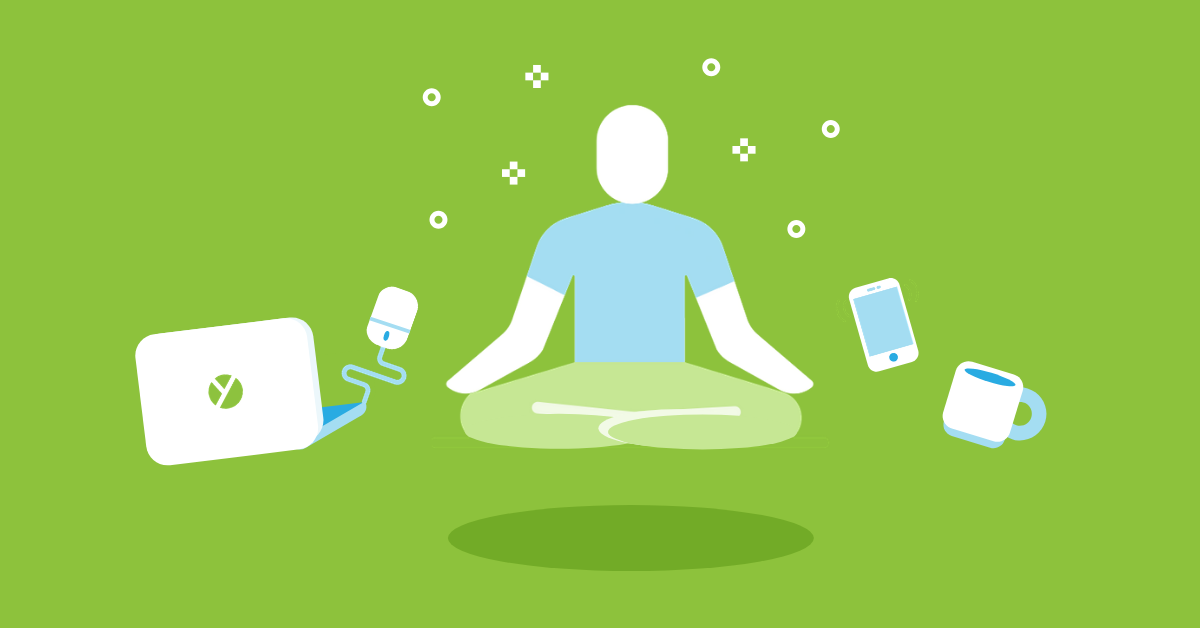“Slow Down to Speed Up”: Meditation Tips for Salespeople
Sophia Seltenreich
We get it. Your day piles up with demands on time and attention faster than you can say “cold call.” Whether you’re heads-down prospecting, meeting with your sales team, or simply trying to survive the 100 calls you have scheduled, you’re focusing most of your attention outward.
Yet to borrow from Yesware Founder and meditation crusader Matthew Bellows, “Instead of being swept up in the crazy rush of activities, it’s important to maintain some perspective on the flurry. Not only does meditation help you understand your own mind and what’s preventing you from getting to the next level, but it also helps you navigate your relationships with prospects, customers, coworkers, and investors.”
In this sense, meditation is good for the body, the mind, and the business.
Center Yourself
You can’t have laser-like focus unless you know how to center yourself.
“I am passionate about bridging both worlds—delivering ancient wisdom but also grounded in current advances in neuroscience and other research,” says Jaymie Meyer, a wellness expert specializing in meditation, stress management, and therapeutic yoga based in New York City. Through her business, Resilience for Life, Meyer has delivered stress reduction and wellness workshops for nearly 20 years, at work sites and educational institutions including the National Institutes for Health, IBM and Panasonic.
And here’s what Meyer has to say about the role meditation can play in the life a no-nonsense sales pro: “Training the brain is not unlike training yourself to learn how to play a musical instrument or ride a bike. People understand that.”
It’s also probable that you understand this, too: Scattering your energy in 1,000 different directions gives you all the focus of a cheap flashlight on low batteries. You can’t have laser-like focus unless you know how to center yourself. But to do that, you have to slow the rapid spin of thought and direct your mental and emotional energy on things that matter most. Meditation is definitely a gateway to achieving this.
“The benefit of learning how to disengage our attention from our thought stream is that we can then apply our minds more readily towards constructive things, such as completing goals and connecting with other people,” says Jeffrey Gitterman, co-founder of Beyond Success, a consulting firm that brings holistic values to the business and finance worlds. “Meditation creates space within us—an opening that allows more energy to flow into us.”
The question is: How do we do this? It’s easy to laugh at the novice who hasn’t tried meditation for their lack of experience. “How do you breathe? What do you do?” Like anything else, meditation and controlled breathing are disciplines that you can learn and then practice. You only need to be willing, and have a level of commitment as you get the hang of it.
Tips for Getting Started
Here are some tips for developing a better understanding of the meditation practice, and for getting started:
1. Find a resource
As meditation becomes more commonplace, centers and classes are becoming more accessible. If you can’t a dedicated meditation center in your area, Yoga studios are a good back-up, as many offer meditation classes. It’s like yoga, without the stretching.
For those of you who’d prefer to meditate solo, there are great (free) apps to walk you through guided meditation.
Mobile meditation apps:
- Insight Timer – Meditations based on time & mood
- Stop, Breathe & Think – Meditations based on how you feel
- 10% Happier – Meditation for skeptics
2. Give it three weeks
“I encourage people to give it at least 21 days,” Meyer says.
“It’s helpful for people to have a guide and support during that time so they can ask questions and be inspired. It’s also normal for the brain to resist change and to default back to the status quo, even if the status quo is not serving you. People often need to hear that to understand why they experience resistance and why it may seem hard at first.”
3. Practice as you go
Think you need an hour to meditate? “I recommend mini-meditations and have taught them all over the world,” says Kathy Gruver, Ph.D. “You concentrate on the breath and on the inhale think, ‘I am,’ and on the exhale think, ‘at peace.’ This stops the stress response and readies our brain for higher functioning.”
If you’ve got more time on your hands, try longer meditations. Bellows would meditate anywhere from 4 to 12 hours a day in his time before founding Yesware. While you don’t need to meditate for 12 hours daily, Bellows shares that “there’s nothing like sitting in a room, doing nothing for hours on end, for you to get to know your mind.” He says “you start to get your patterns of thought, you have time to think about what your life is about, and what you want your life to be.”
4. Identify goals/issues you want to work on through meditation
Whether you struggle to manage anger at work or hope to visualize new sales breakthroughs, meditation can help on both fronts. But the important thing is to learn the ropes first before you dive headfirst into problem-solving mode. Just learning how to meditate will reap benefits as it elicits something Dr. Herbert Benson famously labeled “the relaxation response.”
If you’re still not convinced…
Get sales tips and strategies delivered straight to your inbox.
Yesware will help you generate more sales right from your inbox. Try our Outlook add-on or Gmail Chrome extension for free, forever!
Related Articles
Ginelle DeAntonis
Casey O'Connor
Casey O'Connor
Sales, deal management, and communication tips for your inbox

